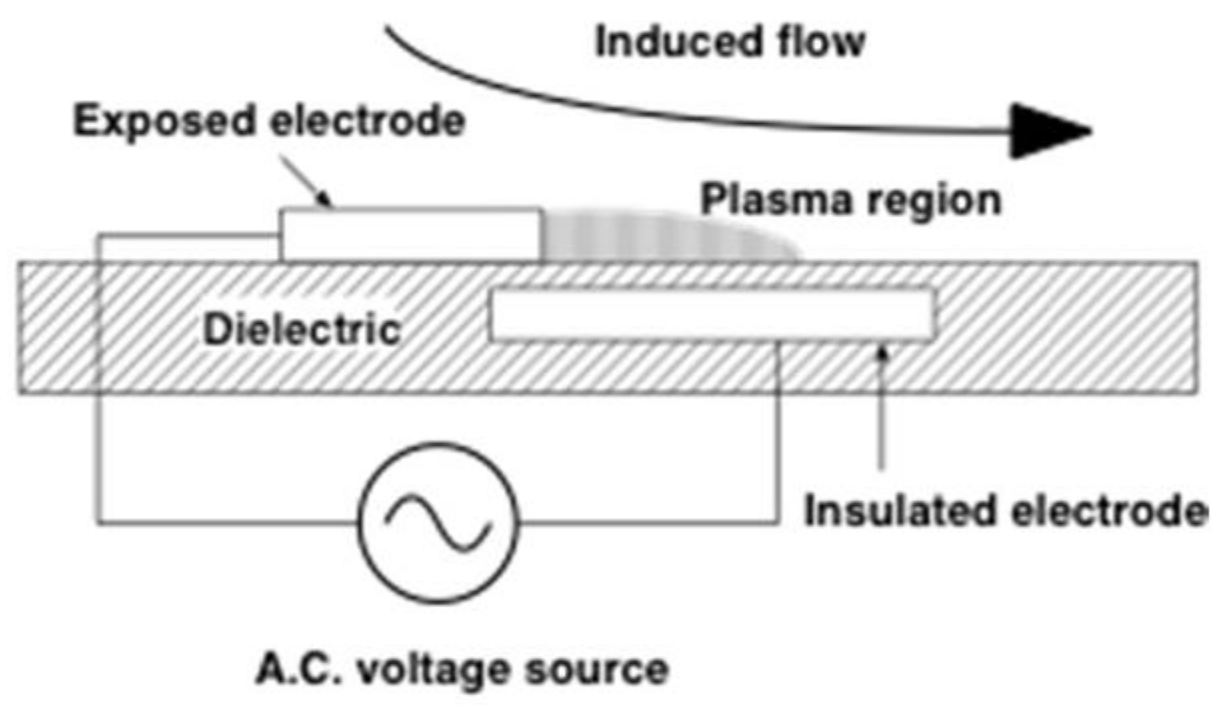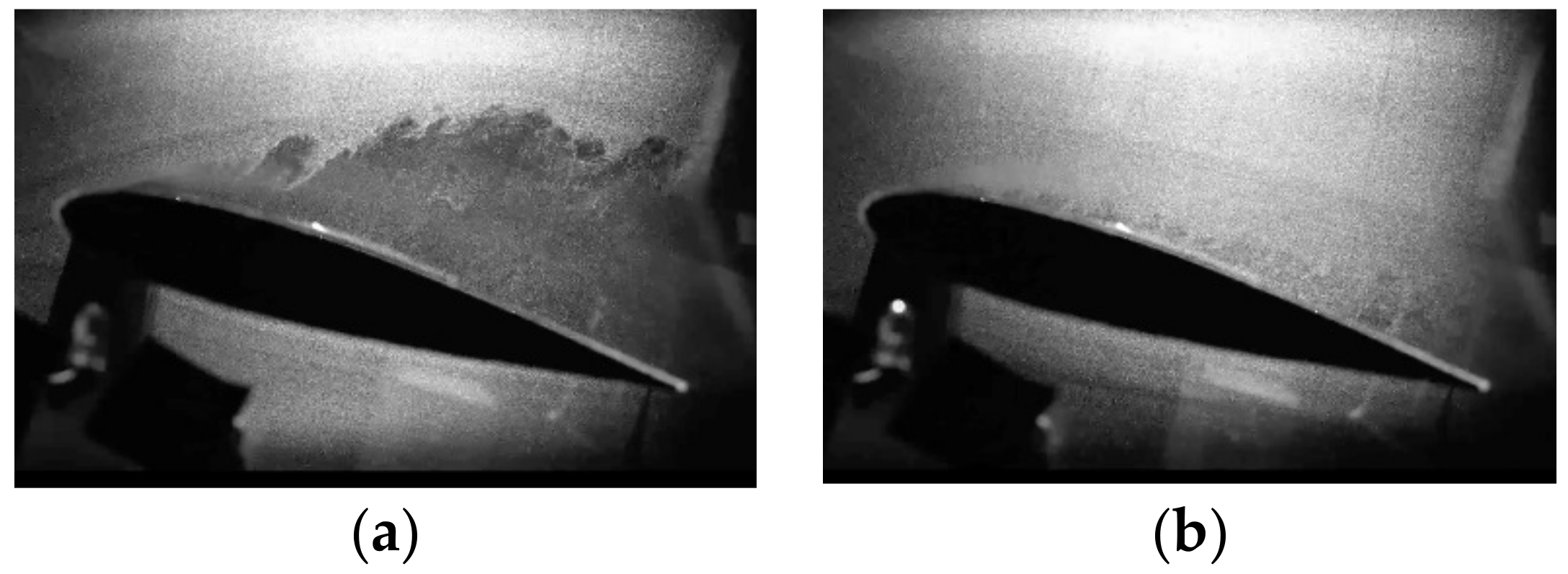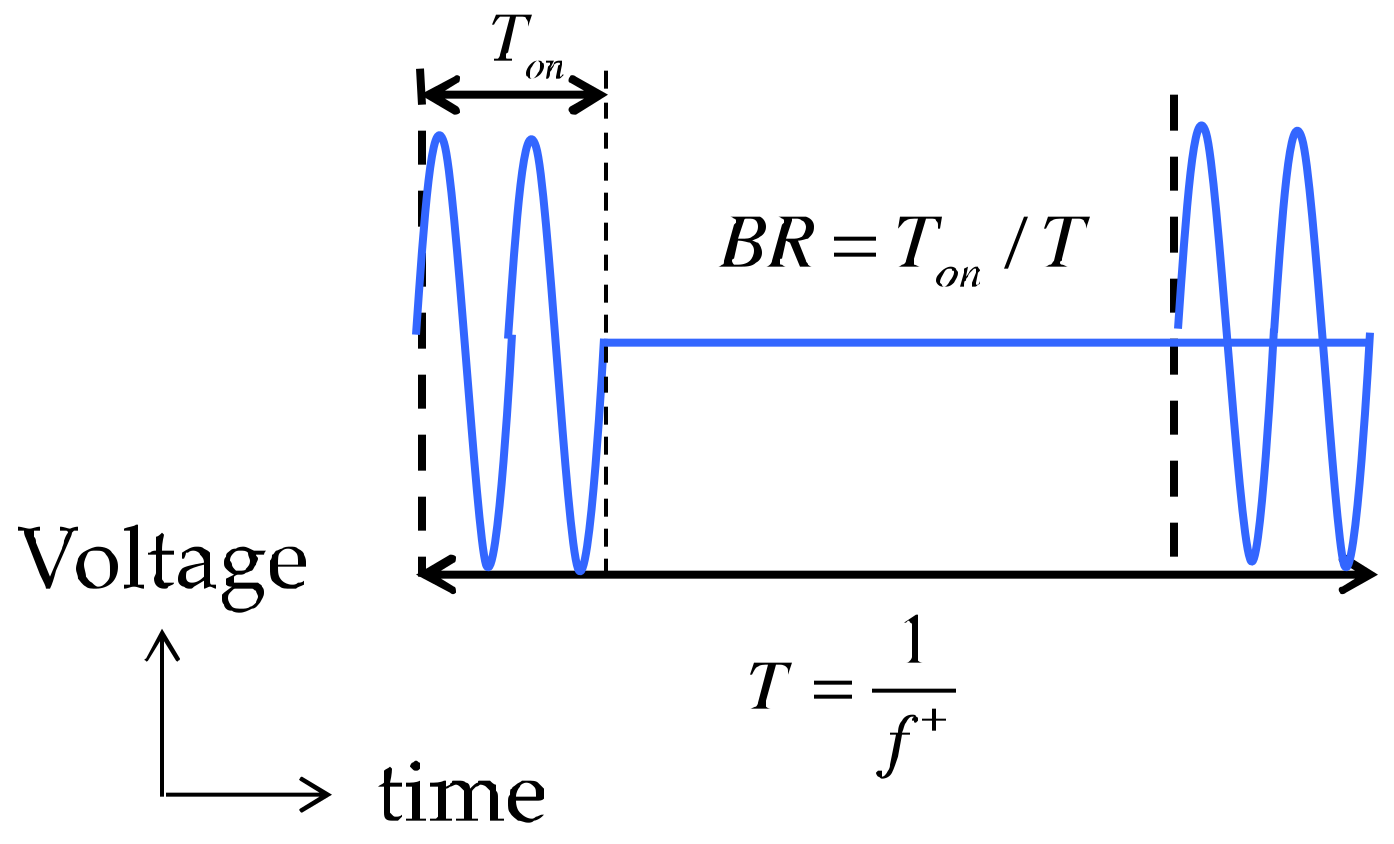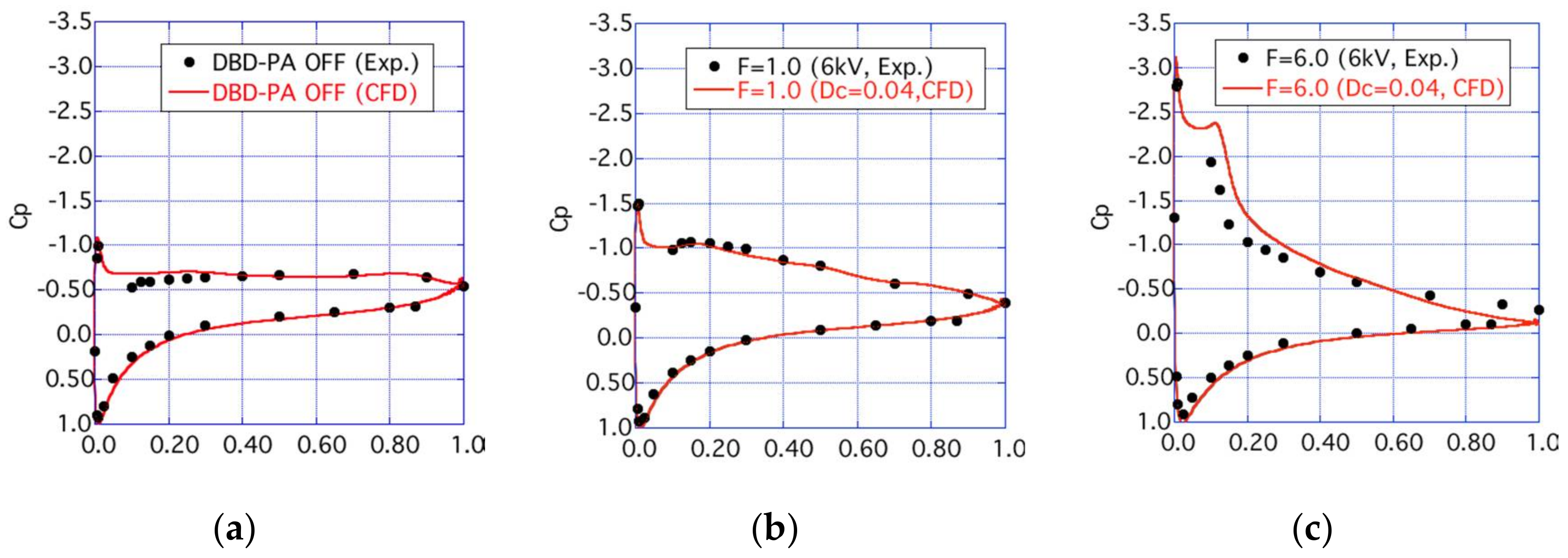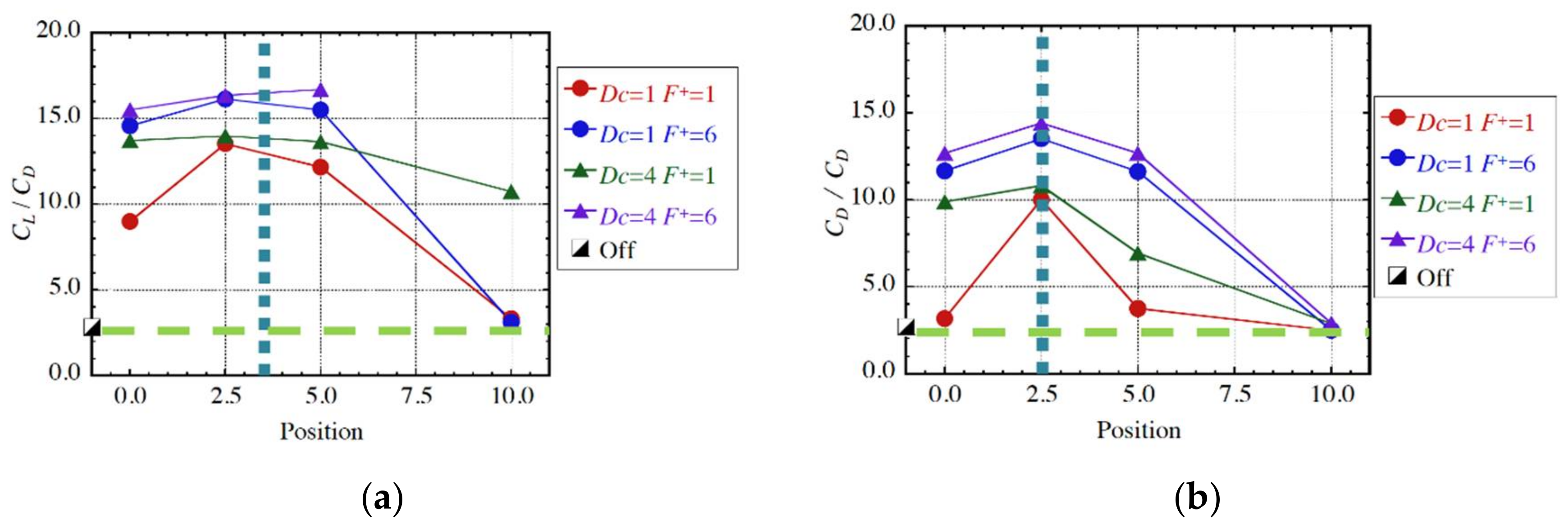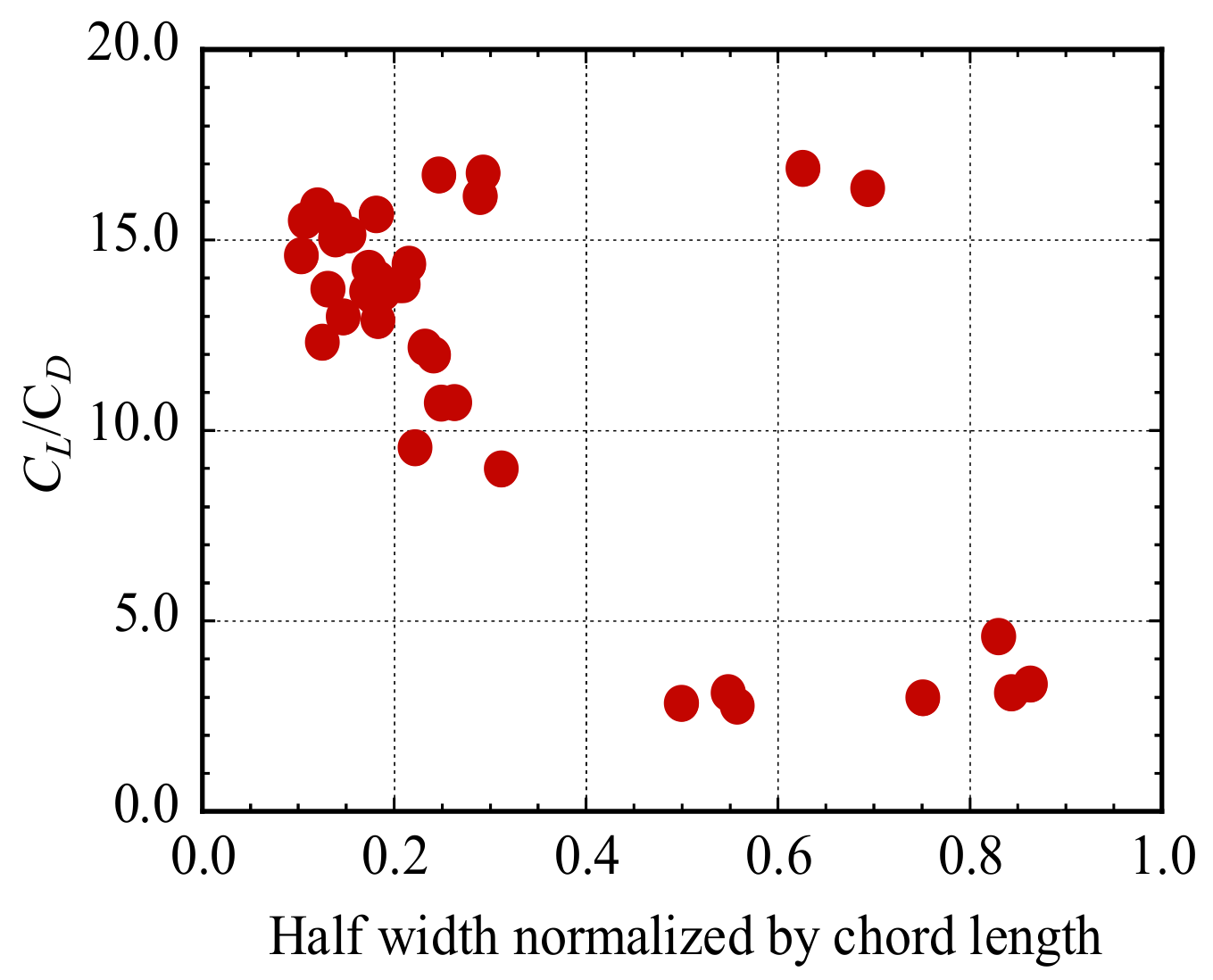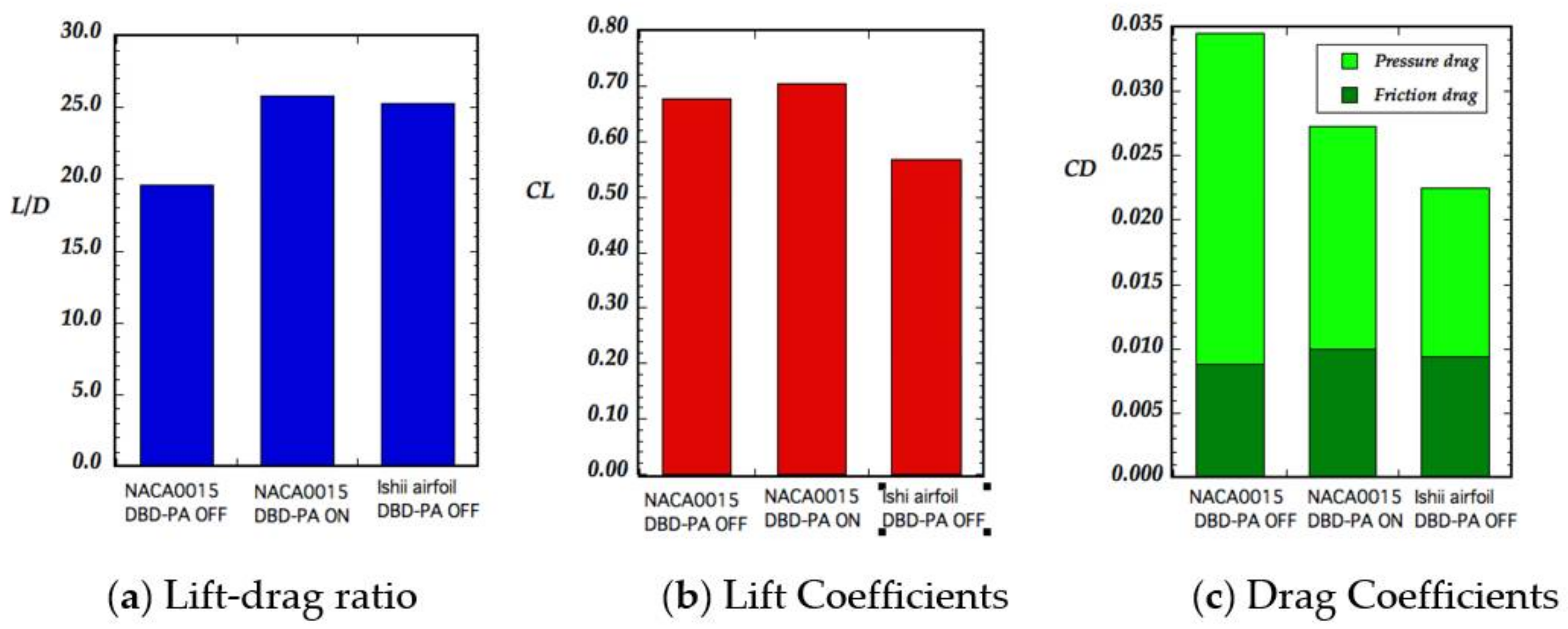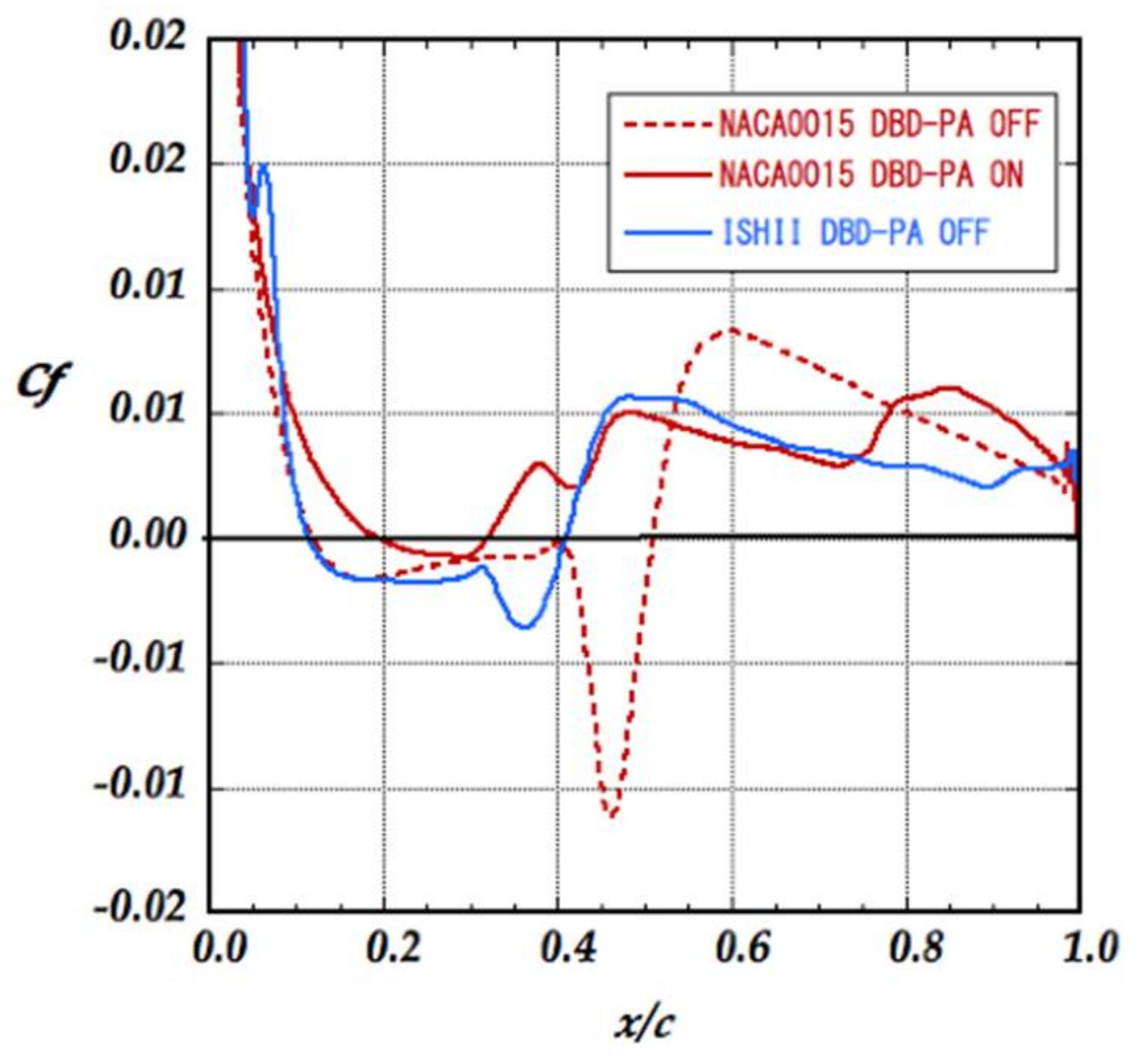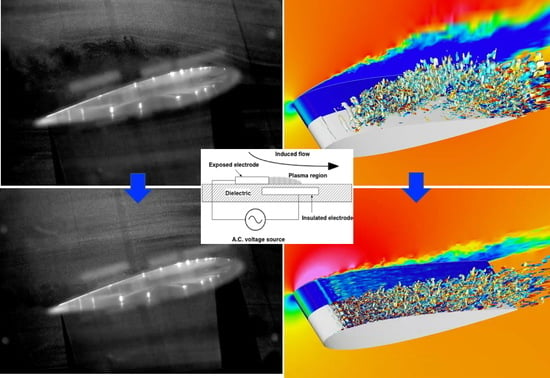In the following discussions, there are both computational and experimental results. The results presented in the figures are computational ones unless “Experiment” appears in the figure caption.
5.1. Use of Burst Waves: Observations in Our Early Study
As described in
Section 1, burst waves are effective for better control of flow separations.
Figure 5 shows the experimental result showing the effect of burst frequencies over the lift coefficients
at the angle of attack of 12°, which is just above the stall angle. Here,
L is the lift of the airfoil and
c is the chord length of the airfoil representing the length scale.
BR is the percentage burst ratio and
BR = 100% corresponds to the continuous mode of the applied voltage. Although not shown here, the
CL value without the DBD plasma actuator was about 0.55. This indicates that continuous mode (BR = 100) did not increase
CL value and was considered to not effectively change large-scale leading-edge separation. Burst mode actuation is in general more effective than continuous mode actuation. A frequency of
f+ = 600 Hz (corresponding to the non-dimensional burst frequency,
F+ = 6.0) with a burst ratio (
BR) of 10% is very effective. In the literature, it had been shown that
F+ =1.0 (
f+ = 100 Hz in this experiment) was very effective for achieving a high
CL [
12,
16] although the effectiveness of a much higher
F+ was not confirmed. For the future discussion in this manuscript, please note that the applied voltage in this experiment was 4.0 kV (
Vpp), which is low compared to many other experiments for the DBD plasma actuator. This sensitive low voltage was intentionally chosen so that we could find the effect of the burst frequency and other plasma actuator parameters on the aerodynamic coefficients. With higher voltages being applied, the difference in
CL values between
BR = 50% and
BR = 10% became smaller and the effect of the burst frequencies decreased. At any rate, the experimental results posed two questions: Why did the burst mode show better flow control authority? Why did
F+ = 6.0 realize higher
CL compared to
F+ = 1.0 in this experiment?
As the angle of attack is just above the stall angle and the applied voltage is very low for the case shown in
Figure 5, the results in the experiment were very sensitive to a small change in the flow and environmental conditions. Therefore, 14°, which is a few degrees above the stall angle, was selected for the main case for the discussion below. Experiments were also conducted at this angle of attack with higher voltages (5.0 kV–6.0 kV (
Vpp)) [
38].
Figure 6 shows plots of surface
distributions over an NACA0015 airfoil under three different DBD plasma actuator conditions: (a) DBD-PA OFF (plasma actuator not used); (b)
F+ = 1.0; and (c)
F+ = 6.0. The burst ratio was set to be 10 (10% duty cycle) for all the cases. Flows are unsteady, so the plotted CFD data are based on the time and span-averaged values. The computational results were obtained through the present extensive study. The experimental result was taken from Ref. [
39]. The simulation results in all the three plots show good agreement with the corresponding experiment. Without the DBD plasma actuator, there are flat
Cp distributions over the upper surface of the airfoil (shown in
Figure 6a), which indicates that flow separation occurs at very near the leading-edge. With the DBD plasma actuator on, negative pressure is produced over the upper surface of the airfoil and the lift coefficient is somewhat recovered. Better flow control with higher burst frequencies is also confirmed in this CFD analysis since the leading-edge suction peak is well recovered in Case (c) with
F+ = 6.0. At angles of attack below the stall angle, laminar flow separation occurs near the leading edge of the airfoil when without the DBD plasma actuator. A turbulent transition makes the separated flow to attach to the airfoil surface at this Reynolds number. The small separation region that occurs as a result is called the “laminar separation bubble”. Such phenomenon seems to have occurred at a higher angle of attack as well in Case (c).
Table 1 shows the aerodynamic coefficients for all the three cases in
Figure 6. As expected from
Figure 6b,c,
F+ = 6.0 produces a higher
CL than
F+ = 1.0, which is consistent with the result of the experiment shown in
Figure 5. Here, it should be noted that higher
L/
D is obtained and the suction peak is also recovered for
F+ = 1.0 when
Dc is increased (namely, when a higher voltage is applied). Then, the result becomes close to that for
F+ = 6.0.
5.2. Use of Burst Waves: Observation from the Later Stage of Study (2011–2017)
From the results thus far, the two questions raised earlier have not yet been answered. The first was why the use of burst waves improved flow control authority, while the second was why
F+ = 6.0 showed a better flow control than
F+ = 1.0 in both our experiments and simulations. Numbers of iLES simulations were conducted under the project of application software development of the K supercomputer in Japan [
40,
41,
42,
43,
44]. Simulations with different parameters (airfoil geometry, angle of attack, Reynolds number,
Dc,
F+, etc.) identified the solutions to these questions. Other extensive studies have been conducted in the experiments similarly [
39]. Much information was obtained by this activity. Some of the results are presented here among them. More results can be found in the references above.
Figure 7 shows the effect of the actuator position [
45]. Thick vertical dotted lines are the separation points when without the DBD plasma actuator. As has been pointed out in the past, a DBD plasma actuator achieves the best
L/D when it is located near the separation points. This is also true for other angles of attack, other airfoils and other DBD plasma actuator parameters.
Next, we discuss the answers to the two questions above.
Figure 8 illustrates how aerodynamic performance (
L/D) is influenced by the chordwise growth of the turbulent energy. Each symbol in this figure corresponds to one simulation. We first drew the TKE (turbulent kinetic energy) contour map over the entire flow field over the airfoil. At each chorwise station from the leading edge, the maximum value of TKE is searched in the lateral direction. Thus, we obtain the chordwise distribution of the maximum value of TKE for each chordwise location (TKE_max). The chordwise distribution of TKE_max has a peak and Gaussian-like profile near the peak. The half-width of the first peak of TKE_max profile is computed as a reference value of the rapidity of the TKE growth (or turbulent energy promotion) as it is considered to have strong relation with the smoothness of the turbulent transition. Each point in this figure corresponds to the
L/D versus the rapidity of the TKE growth thus computed for each case. Details on the method used for computing the rapidity of the TKE growth have been discussed [
40]. There are obviously three groups in this figure. One group at the bottom right shows a slow growth of turbulence, resulting in a low
CL/
CD (same as
L/D). They fail to achieve good flow separation control. The other group at the top left has a rapid growth of turbulence, resulting in a high
L/D. They are successful in flow separation control. These results indicate that the promotion of the TKE energy, namely, the promotion of laminar–turbulent transition is one important mechanism for the separated flow control by the DBD plasma actuator. There is an interesting third group located in the top left region. They are successful for flow separation control and achieve high
L/D even though the growth of turbulence is slow. This suggests that another mechanism may exist for the flow separation control authority of the DBD plasma actuator. Note that analysis of the instantaneous flow for this group shows a two-dimensional spanwise vortex remaining near the airfoil surface up to the middle-to-rear part of the airfoil, where a transition occurs. This phenomenon ensures a high
L/D.
5.3. Three Important Flow Features and the Guidelines from the Observations
Another interesting feature that may be related to the existence of the third group is shown in
Figure 9a,b, where the
L/D dependence on the burst frequency
F+ is plotted for NACA0015 and NACA0006 airfoils, respectively. The figures show that a higher frequency (
F+ = 6.0) is more effective for achieving a higher
L/D for the NACA0015 (a thick airfoil) as has already been described, while a lower frequency (
F+ = 1.0) is more effective for the NACA0006 (a thin airfoil) independent of any actuator locations and values of
Dc. There thus occurs another question: Why does a low burst frequency (
F+ = 1.0) work better for a thin airfoil such as NACA0006, while a high frequency such as
F+ = 6.0 works better for a thick airfoil such as NACA0015? It should be noted that the values of
Dc in
Figure 9a,b are much smaller than those in
Figure 7. Although the Reynolds number was same, the
Dc values in our early simulations shown in
Figure 7 were determined based on the longer chord and lower freestream velocity, which are different from those in the experiment described here. As a result, the
Dc values became large and the region of the DBD plasma actuator was small (relative to the model scale). We confirmed, however, that same conclusion was also obtained for the smaller
Dc values.
An analysis of the instantaneous flow fields, phase-averaged flow fields, frequency spectrum, and linear stability of the separated shear layer was performed. Such effort led to identifying a few different representative flow features [
39,
46]. As has been described, the turbulent transition turned out to be one of the most important factors for the flow separation control at this Reynolds number. To further confirm this estimation and find appropriate burst parameters for better flow control, the linear unstable modes in the separation shear layer profile and the spatial growth rates were investigated [
40,
47]. The most unstable frequency was approximately
St = 15 in the separated shear layer flow structure when the DBD plasma actuator was off. Here,
St is the non-dimensional frequency defined by the chord length and the freestream velocity. The most unstable frequency was approximately
St = 35. when the DBD plasma actuator was turned on. The DBD plasma actuator in the burst mode creates two-dimensional spanwise vortices at the beginning and at the end of every bursting. They merge together and a stronger two-dimensional vortex with the same frequency as
F+ is eventually appears. This implies that the vortices created initially for the case of
F+ = 6.0 have a Strouhal number similar to the unstable frequency
St = 15. Higher-frequency components are also created, so low input frequencies such as
F+ = 1.0 would have similar frequencies as harmonics, but the higher input frequency
F+ = 6.0 has much higher power spectrum density components at the most unstable frequency than
F+ = 1.0. This might be why actuation is more effective for
F+ around 6.0 than for
F+ around 1.0 at this angle of attack. A similar analysis was conducted for the flow separation control by the synthetic jets [
47,
48]. Here, strength of the induced flows is not too important, but the frequencies of the disturbance introduced by the DBD plasma actuator are important.
A two-dimensional vortex created by the burst mode actuation described above is another important feature that plays an important role in the flow separation control. Such flow structures were found in the time sequence of the flow fields obtained through the phase and spanwise averaging of the simulation data. They were also experimentally observed.
Figure 10a–d shows an instantaneous snapshot of the PIV particle images in several cases [
38].
Figure 11a,b shows two image shots of the computed flow fields obtained with the ensemble and moving average [
27,
40]. A sequence of vortices is observed, and the number of these vortices corresponds to the burst frequency
F+. These vortices are important because they promote large-scale momentum exchange, which contributes to better control of separated flows and increase the authority of the plasma actuator.
A small disturbance related to the unstable mode of the shear layer would effectively work when the shear layer stays sufficiently close to the airfoil surface. This occurs for the thick airfoil at an angle of attack just above the stall angle because thick airfoils have large radius of curvature at the leading edge. When the airfoil is thin, a separated shear layer is located far away from the surface as the radius of curvature at the leading edge is small. Small flow disturbances may not be sufficient to induce a separated shear layer coming closer to the airfoil surface. Basically, a smaller F+ creates stronger and larger vortices. Therefore, actuation with F+ = 1.0 creates larger and stronger two-dimensional vortices. These strong vortices might be capable of inducing the separated shear layer to move closer to the airfoil surface. This might be why F+ = 1.0 work better for the NACA0006 airfoil, and F+ = 6.0 works better for the NACA0015 airfoil. Similarly, when the angles of attack are much higher than the stall angle, the shear layer separated from the leading edge stays further away from the airfoil surface. Therefore, F+ = 1.0 also works well. In summary, these vortices would work efficiently especially when a separated shear layer stays away from an airfoil surface.
The two flow features above depend on the parameters of the burst mode. On the other hand, the actuator-induced streamwise momentum always exists. It depends on the input voltage, base frequency and others. Thus, jet-like flows introduced by the plasma actuator near the airfoil surface are another important flow feature. The induced momentum becomes largest in the continuous mode and becomes smaller for lower burst ratios.
All three of the flow features described above always exist in the flow field induced by a DBD plasma actuator. By a proper choice of the actuator parameters such as the voltage, base frequency, burst frequency, and burst ratio, some of the flow features can be enhanced and become dominant in the flows. By optimizing the parameters for the flow and geometry conditions to be applied, good control of flow separation can be achieved. Therefore, a plasma actuator works more efficiently than other flow control devices.
The strategy for choosing the good parameters for the DBD plasma actuator can now be determined based on the discussion above. It is more effective to use a high frequency considering the instability of the separation shear layer when the separation is weak, or the shear layer stays near the airfoil surface. We can control the flow separation with a low input voltage. It is more effective to use a frequency that is low enough to create strong and large two-dimensional spanwise vortices. Needless to say, it is always more effective to increase the input voltage which induces stronger jet-like flows. The DBD plasma actuator works better than other flow control systems since all the three flow features work together. With the parameter selections optimized for the application and the flow conditions, some of these effective features become dominant, which expands the applicability of the DBD plasma actuator for flow separation control.
5.4. Additional Issues
A few issues are raised below from the extensive CFD and experimental studies. Firstly, it is found that the DBD plasma actuator, particularly in the burst mode, promotes a transition to turbulent flows and a laminar separation bubble near the leading edge becomes small due to the early reattachment. The time-averaged boundary layer profile shows that the boundary layer after the reattachment is essentially turbulent [
40]. However, the attached turbulent boundary layer maintains a periodicity corresponding to the frequency of the burst mode as described above. The author’s understanding from the analysis of the time history is that the role of the DBD plasma actuator is not to attach separated flows but to move the separated shear layer closer to the surface and prevent flow separation by maintaining two-dimensional vortex structure near the airfoil surface. This type of flows can also be observed in the flows at angles of attack slightly lower than the stall without a DBD plasma actuator. The flow structure is also somewhat similar to what is observed in the laminar separation and laminar reattachment flows over an airfoil at lower Reynolds numbers [
35].
When we discuss the flow control authority of the plasma actuator, we have to define what is “good authority”. The definition may be different for different people and for different applications. For example, the lift coefficient
CL shows a similar trend to that for
L/
D (lift to drag ratio, where
D is drag) in many cases. Among them, there are cases where
values become large. One example may be the case of
F+ = 1.0 in
Table 1. A similar result may be found in the case at higher Reynolds numbers, as shown in
Figure 12. The experiment was carried out with an airfoil chord length of 0.2 m (two times longer than the experiment discussed above) and a freestream velocity of 60 m/s (six times higher than the experiment discussed above) in the wind tunnel owned by a private company. In some cases, negative
Cp distributions over the upper surface were obtained and the lift was somewhat recovered, as observed in the plots in
Figure 12. However, suction peak near the leading edge is not recovered and flow control is not satisfactory. The flow for this type of
Cp distributions tends to show a relatively high
CD. There are relatively large two-dimensional spanwise vortices (which maintain a negative pressure there) aligned over the upper surface as in
Figure 10b. The flow structure in these cases also tend to have strong flow unsteadiness. This type of use is acceptable if the objective in using DBD plasma actuators is simply to increase the lift. However, it is not acceptable if the objective is to keep aircraft flying at more than the stall angle of attack.
Flow structures at this Reynolds number commonly include laminar separation near the leading edge, a transition to turbulence, and reattachment. A so-called laminar separation bubble is created. We may evaluate the flow control authority of the plasma actuator by the early reattachment of the laminar separation bubble, or the size reduction of this laminar separation bubble. However, early reattachment does not necessarily mean a high lift or high L/D. Thus, it is important to clarify what the purpose of using the DBD plasma actuator is, and to define a flow control authority consistent with that objective.
Another issue determined in this study is the relation between the leading edge and trailing edge
Cp values and the lift, drag and
L/
D. Our data mining result showed strong relation between the
L/
D and the
Cp value at the trailing edge [
49]. Sometimes, data acquisition for a certain region over the airfoil becomes difficult, as the dielectric of the DBD plasma actuator covers the airfoil surface. We may be able to estimate the aerodynamic performance by simply measuring the
Cp at the trailing edge.
It should be noted that the flow control authority of DBD plasma actuators depends on the combination of the velocity and the model scale even at the same Reynolds number. The control performance should be discussed for the velocity and model scale specified. Even under the conditions of the same Reynolds number, the control authority of the DBD plasma actuator is different in the case the velocity scale (induced flows relative to the freestream velocity) and the model scale (the size of the plasma actuator relative to the size of the airfoil) are different.
5.5. Functions of Plasma Actuator at Cruise Condition
Thus far, we have only discussed the flow control authority of the DBD plasma actuator to avoid large-scale flow separation over an airfoil. This may be useful for avoiding aircraft stall. However, such a flow condition rarely occurs and therefore applications may be limited from the viewpoint of aeronautical engineering. We may need to show that a higher
L/
D would be obtained at cruise conditions. In this section, we show how the DBD plasma actuator works at the cruise condition and show another benefit of the DBD plasma actuator at a Reynolds number of the order 10
4 to 10
5 with the CFD analysis. The numerical approach is the same as above except for the angles of attack. The aerodynamic performance of an NACA0015 airfoil with a DBD plasma actuator is compared to that for the Ishii airfoil which is a high-performance airfoil at this Reynolds number range and is commonly used for model airplanes. Details of the analysis have been previously published [
50] and only the key issues are described in this section.
The Reynolds number is set to be 63,000. The lift to drag ratios for both the NACA0015 (without a DBD plasma actuator) and the Ishii airfoil are computed in advance and the angle of attack that achieves a maximum
L/
D is selected to be the flow condition for each airfoil. The angles of attack was 6° for the NACA0015 and 4° for the Ishii airfoil, respectively. Under these conditions, the flow is almost attached except in the region of the laminar separation bubble over the upper surface of the airfoils. The computed aerodynamic coefficients are presented in
Figure 13a–c.
Figure 13a shows that the NACA0015 airfoil, when it has the DBD plasma actuator, successfully achieves a higher
L/
D than that for the Ishii airfoil. Although the difference is only a few percent, there are several additional benefits. Firstly, the thickness of the Ishii airfoil is 7.1% of the chord length and that of the NACA0015 airfoil is 15.0%. We could use much thicker airfoil, which would greatly alleviate structural restrictions. Secondly, we might be able to have a high
L/
D for a wide angle-of-attack range with optimized choice for the parameters of the plasma actuator. In addition, we might obtain a still higher
L/
D by finding a suitable angle of attack where the
L/
D attain the maxim value with the DBD plasma actuator. Thus far, we have only tried the angle of attack when the
L/
D attains the maximum value without the DBD plasma actuator.
Figure 13b,c shows the lift and drag coefficients. From these graphs, a high
L/
D was achieved mainly by the drag reduction rather than by lift increase. Reduction of pressure drag is the main reason. To find out why this occurred, the skin friction coefficients over the upper surface are plotted in
Figure 14. The chordwise pressure coefficient (
Cp) distributions over the airfoil surfaces are also plotted in
Figure 15. A recirculating region due to a laminar separation bubble is located further forward for the Ishii airfoil compared to that for the NACA0015 airfoil without the DBD plasma actuator. The NACA0015 airfoil without a DBD plasma actuator has a separation bubble up to almost 50% of the chord, which increases the pressure drag. With a DBD plasma actuator “ON”, this region becomes very small and moves forward. The reattachment point become almost the same as that for the Ishii airfoil. By moving the low-pressure region inside the separation bubble forward, the pressure drag is remarkably reduced.
The pressure distributions for an Ishii airfoil plotted in
Figure 15 shows a pressure plateau region in the forward part of the airfoil, which corresponds to a laminar separation bubble. Typically, reattachment occurs via a laminar-to-turbulent transition. However, the flow stays laminar even after the reattachment in this case.
Figure 16 shows the power spectrum density of the chordwise velocity fluctuations. The power spectra are measured at several points in the chordwise direction along the line of the maximum turbulent-kinetic-energy (TKE) in the chordwise direction. The horizontal axis represents the Strouhal number
and the vertical axis represents the power spectrum density. In this analysis, data are ensemble and spanwise averaged, and the power spectra are non-dimensionalized as the power spectrum density,
. The spectrum for the DBD plasma actuator off case has a peak around
St = 10 at
x/
c = 0.4, which may correspond to the most unstable mode of the linear stability. From
x/
c = 0.4 to 1.0, a −5/3 power decay can be clearly observed, and the flow is considered to be turbulent. This result is consistent with the pressure distributions in
Figure 14 and
Figure 15. On the other hand, −5/3 power decay is not observed for the Ishii airfoil almost up to the trailing edge. It seems that flow stays laminar even after the reattachment. The NACA0015 airfoil, with the DBD plasma actuator on, the location of the power decay moves toward the trailing edge and occurs somewhere between
x/
c = 0.8 and
x/
c = 1.0 (
Figure 16b). The DBD plasma actuator seems to establish similar flow structures as that for the Ishii airfoil in
Figure 16c. It is interesting to note that the DBD plasma actuator in this case delays the transition. At high angles of attack, the DBD plasma actuator promotes a laminar to turbulent transition to avoid flow separations. Even though the parameter settings are very similar, the DBD plasma actuator works very differently than it does at high angles of attack.
Figure 17a–c shows instantaneous snap shots of the flow field. As explained for
Figure 16, a two-dimensional vortex structure remains up to the rear part of the airfoil surface and the transition seems to be delayed when the DBD plasma actuator is turned on (
Figure 17b). This flow structure is very similar to that for the third group plotted in
Figure 8. The transition point moves upstream at a certain instance. Then, the DBD plasma actuator pushes it back toward the trailing edge by sweeping out the disturbances and the two-dimensional vortex structure induced by the actuator becomes dominant over the upper surface of the airfoil. Next, transition point moves back to forward again. This phenomenon repeats periodically, as shown in the video animation in the
Supplementary Material.
We still have not identified some of the flow features and we need more studies to understand in what case the DBD plasma actuator promotes the transition and in what case it delays the transition. However, this small electric device is very effective for many types of flow control applications.
